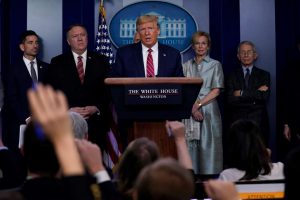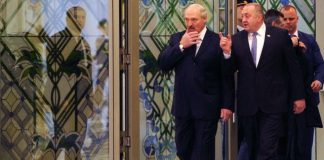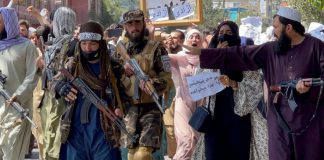APRIL 12, 2020

President Donald Trump speaks during a coronavirus task force briefing at the White House on Friday. – Evan Vucci, AP
WASHINGTON, D.C. – President Donald Trump is eager to reopen the nation and claims to have “absolute authority” to do so, but experts say the decision on when Americans can ditch coronavirus distancing and return to normal will ultimately be made by governors.
Trump is set to announce a new task force Tuesday that will focus solely on whether the administration should extend federal social distancing guidelines past May 1 or attempt to reopen parts of the country to blunt the economic consequences of the pandemic.
As U.S. unemployment claims soar because of the coronavirus, the president has indicated a desire to ease guidelines in less hard hit states. He has acknowledged he must balance that goal against fears of reigniting hot spots or creating new ones.
“I’m going to have to make a decision, and I only hope to God that it’s the right decision,” Trump said Friday at the White House. “It’s the biggest decision I’ve ever had to make.”
Trump has framed the decision as one Washington can make unilaterally.
“I have great authority if I want to use it. I would rather have the states use it,” he told reporters Friday. “I have absolute authority to use it.”
But the federal social distancing guidelines his administration rolled out March 16 are not mandatory. Governors may be influenced by the Trump administration, but the decision to lift stay-at-home orders and open schools will ultimately be theirs to make.
New Jersey Gov. Phil Murphy, a Democrat, said Sunday that states could not reopen for business until the health crisis is under control. Acting any sooner than that, he warned on CBS’s Face the Nation, would be like “throwing gasoline on the fire.”
An economic recovery, Murphy added, has “got to be on the back of a full health care recovery.”
More than 40 states have imposed statewide stay-at-home orders for their entire population, according to the National Governors Association.
“We do also have to think about how do we eventually ramp up and get some folks back to work. But you can’t just pick a date and flip a switch,” Maryland Gov. Larry Hogan, a Republican, told ABC’s This Week on Sunday. “I don’t think it’s going to be that simple.”
Federal law allows Washington to impose quarantines in some circumstances and limit travel between states, but the Trump administration has not invoked those powers. And the Supreme Court has struck down attempts by the federal government to intervene within states. For instance, the court noted in a 1985 decision that invalidated Food and Drug Administration rules for blood plasma donation centers that “the regulation of health and safety matters is primarily and historically a matter of local concern.”
“First and foremost, states currently retain power to decide who stays home and for how long,” according to an analysis for Lawfare. “Among the powers generally reserved to the states is the authority to quarantine individuals and otherwise protect public health.”
Those state decisions have sometimes drawn fire from federal officials. Kentucky Gov. Andy Beshear announced Friday that parishioners attending Easter services would face a mandatory quarantine. Sen. Rand Paul and Rep.Thomas Massie, both Kentucky Republicans, quickly slammed the governor’s announcement as an overreach.
Trump has acknowledged a desire to “reopen” the country has at times put him at odds with the advice from public health officials. The makeup of his second task force, which he said will include prominent business leaders, could signal his latest thinking.
The president created a coronavirus task force led by Vice President Mike Pence in late January, a group that includes some of the nation’s best-known public experts such as Anthony Fauci, director of the National Institute of Allergy and Infectious Diseases, and Deborah Birx, who is the White House coronavirus response coordinator.
That group was instrumental in convincing Trump to extend the social distancing guidelines earlier this spring. Presented with projections that at least 100,000 Americans could succumb to the coronavirus, Trump abandoned what he later described as an “aspirational” goal to reopen the country by Easter weekend.
The number of people infected with the virus – and the number of people dying from it – continued to climb over the weekend as policymakers debated next steps. The U.S. surpassed Italy to become the nation with the most coronavirus deaths in the world over the weekend, climbing past 20,000 people according to Johns Hopkins University.
As a proportion of the population, U.S. virus deaths remain at about one-sixth of those in hard-hit Italy or Spain.
The federal distancing guidelines, which were mailed to every residential address in the nation, recommend Americans avoid groups larger than 10, work from “whenever possible,” and avoid discretionary travel, including shopping and social visits.
Courtesy/Source: USA Today










































































































